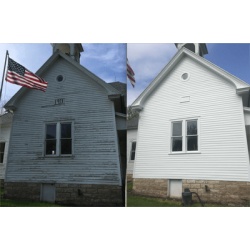
Highlandville School undergoing extensive restoration
If you drive northeast out of Decorah on Locust Road, soon the terrain and scenery change. The road begins to bend and dip, motorists skirt alongside farmland and quarries, and if you take the Big Canoe Road turnoff, lush vegetation from a rainy summer creeps in on the pavement. Driftless Scenic Byway signs dot the roadsides and the high sun of summer seems less sharp and penetrating down here in South Bear Creek Valley; the light more quiet and reserved.
Quiet and reserved also describes the small community I'm entering: Highlandville, population 25. I'm here to learn about the history of the Highlandville School and the intensive restorations it's been undergoing since 2016. Quiet and reserved could also describe the three men I'm interviewing: Highland Township Trustee Rick Monson, Highlandville School volunteer Dave Stanley and local carpenter Zach Maxon. Quiet and reserved, but also proud of the work they've accomplished on this historic landmark.
I'm a Decorah native; but I'm also a city-rat, and besides attending a couple Foot-notes dances at the Highlandville School, I'm very unfamiliar with this community, but I soon discovered a deliberate preservation of history in this charming hamlet, and much of this history has revolved around the schoolhouse.
Immigrants began settling in Highlandville in 1852, and by 1880 there were approximately 50 residents. By 1911, the growing community had 100 occupants and the remote location, coupled with no immediate railroad access, made self-sufficiency a priority. By the time the Highlandville School was constructed in 1911, the community had a doctor and post office, three general stores, a blacksmith, a creamery and flour mill, a couple farm machinery dealers, and a number of mechanics.
During Iowa's early history, small rural schools were the primary method of education. Over a million Iowa children were educated in schools similar to Highlandville School between the 1846 and 1964, when all rural public schools were finally decommissioned. Highlandville School was one of the last rural public schools to be decommissioned; Highlandville residents are very proud of this fact.
The Highlandville School remains largely unchanged since its construction in 1911, due mostly to the consistent upkeep by the Highland Trustees, who bought the schoolhouse for $1 after it was decommissioned in 1964. Since 1964, the school has become a community center for local residents and the broader Northeast Iowa community. As Board of Trustees member Dave Stanley said, "The school has served as an active community center available to the public." Weddings, birthdays, anniversaries, voting, the beloved Foot-notes dances, and a host of other intimate community gatherings have all been hosted at the school.
With funding from the Depot Outlet and the Arlin Falck Foundation, and matching funds from the Highland Trustees, intensive restoration began in 2016, beginning in the interior and recently moving to the exterior. The trampled floorboards are all original, as are the bookcases, windows, piano, and all the hand-crafted glass light fixtures.
On the exterior, the school retains the original wood siding, which Zach Maxon, a carpenter, is currently restoring. But instead of the traditional method of laboriously scraping paint from the wood siding, Zach is simply prying the wood from the schoolhouse, flipping it over, and nailing it back in place—thus exposing to the elements the previously unexposed wood. It looks like new and it saved Zach and the Trustees days of manual labor. Zach has employed this on the east and south fašade, and the Highland Trustees are currently fundraising to restore the west and north face, as well as the historic belfry.
Trustee member Dave Stanley was married at this schoolhouse and its meaning for him is obviously deeply personal. But he's also witnessed the way the schoolhouse has functioned within the community. "The schoolhouse has functioned as a social integrating mechanism in the community, helping to preserve history into the future," said Stanley.
I'm thinking of those words as I say goodbye to Dave, Rick, and Zach, and as I'm driving away, I look over at the east porch of the schoolhouse. A memory rushes to my senses: a decade ago, as a teenager, stumbling out onto that porch, escaping the humid whirling and twirling of the Foot-notes dance and seeking some semblance of fresh air. Countless others have had similar experiences here at the Highlandville School.
You can imagine the school teacher, a hundred years ago, walking out onto this porch after a school day, bone-tired yet rewarded in her work, swatting mosquitoes from her neck and taking a moment to breathe in the muggy summer air. This is what Dave means when he talks about preserving history into the future.
Site designed and maintained by Iroc Web Design Services©.
Your Small Business Web Design Solutions.™


